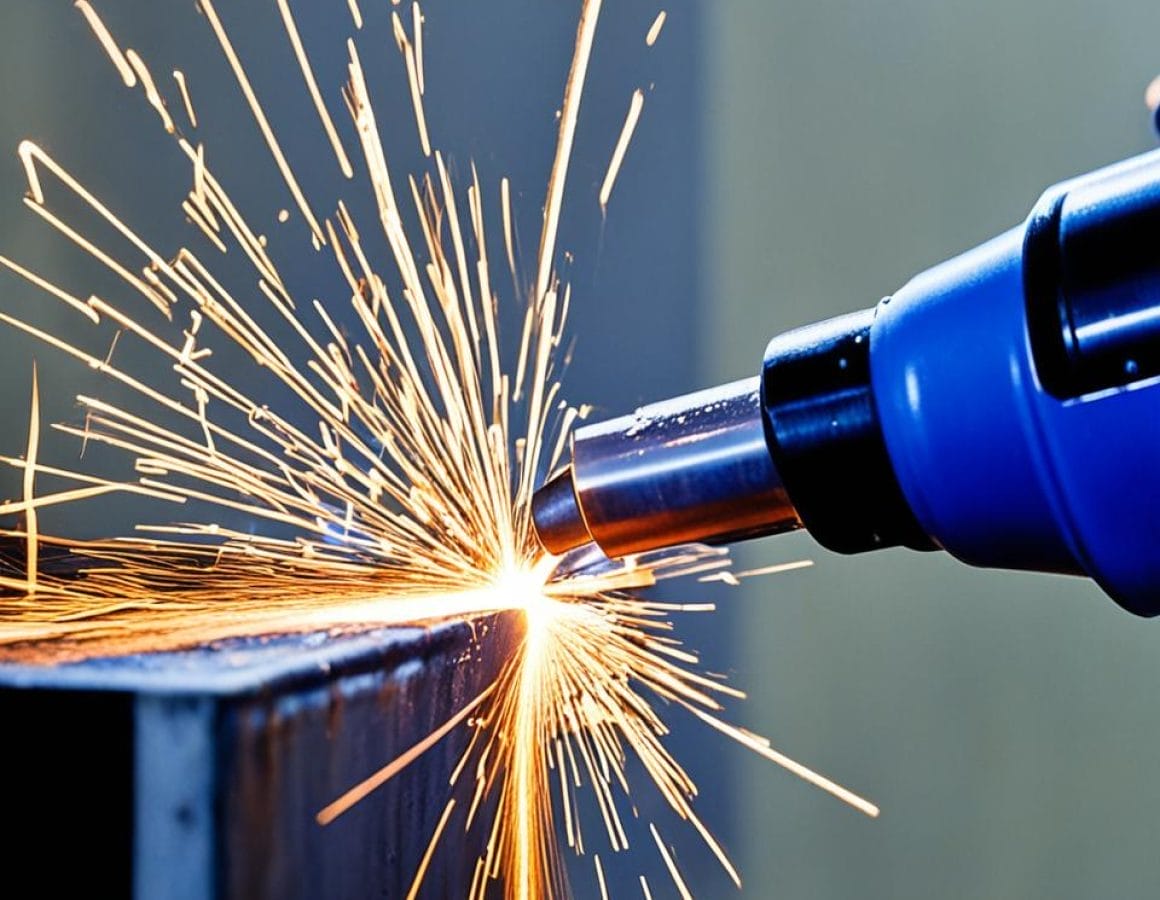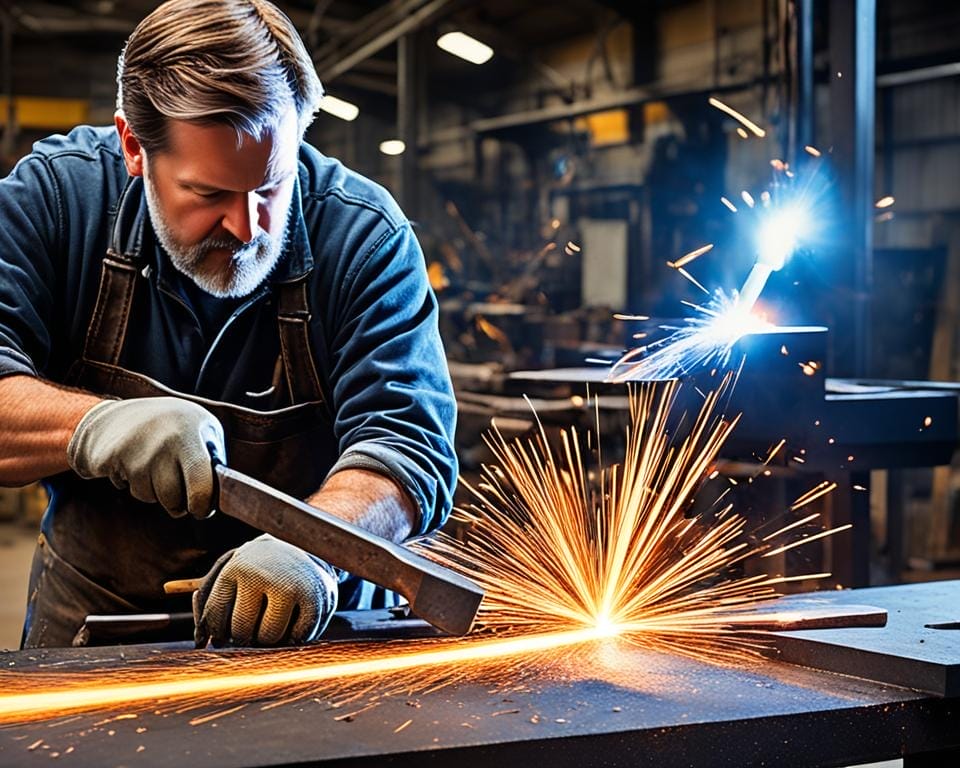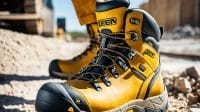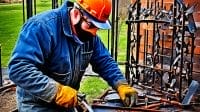Welcome to our comprehensive guide to work metal techniques and tips for beginners. Whether you’re eager to explore metal fabrication, welding, or sheet metal work, we’re here to help you get started on your metalworking journey. With expert advice and valuable insights, you’ll gain the fundamental skills needed to excel in the exciting world of metalworking.
The Essentials of Metalworking Safety
Safety should always be a top priority when working with metal. At company, we prioritize the well-being of our metalworkers and promote a safe working environment. In this section, we will discuss the essential safety guidelines every metalworker should know in order to prevent accidents and ensure a secure workspace.
Also Read: Quality Aluminum Channel Strut for Projects
Personal Protective Equipment (PPE)
When engaging in metalworking activities, it is crucial to wear appropriate Personal Protective Equipment (PPE) to protect yourself from potential hazards. PPE includes but is not limited to:
- Safety goggles or face shields to shield the eyes from sparks, particles, and harmful substances.
- Hearing protection such as earplugs or earmuffs to prevent damage from high levels of noise.
- Heavy-duty gloves to safeguard hands from cuts, burns, and corrosive substances.
- Respirators or masks to filter out harmful fumes, dust, and particles.
- Protective clothing, such as fire-resistant jackets or aprons, to minimize the risk of burns.
- Safety footwear to protect the feet and toes from falling objects or heavy machinery.
By ensuring the proper use of PPE, metalworkers can significantly reduce the risk of injuries and minimize occupational hazards.
Understanding Workshop Hazards
Workshops, by their nature, can present a range of potential hazards for metalworkers. Some common workshop hazards to be aware of include:
- Sharp edges and protrusions on metal objects that can cause cuts or puncture wounds.
- High temperatures and hot surfaces that can lead to burns.
- Sparks, molten metal, and flying debris from grinding, cutting, or welding operations.
- Chemicals and solvents that may cause skin irritation or respiratory issues.
- Heavy machinery and equipment with moving parts that can result in crushing injuries.
- Electrical hazards, including exposed wires or faulty equipment, leading to shocks or electrocution.
Being aware of these hazards and implementing necessary precautions, such as proper training and regular equipment maintenance, can mitigate potential risks and create a safer working environment.
First Aid and Emergency Procedures
Accidents can happen even in the most well-prepared workshops. Therefore, having knowledge of first aid procedures and emergency protocols is crucial for responding effectively to injuries or incidents. Here are some key considerations:
- Ensure that a fully stocked first aid kit is readily available and easily accessible.
- Train employees in basic first aid techniques, such as CPR and treating minor wounds.
- Establish clear emergency evacuation plans and communicate them to all workshop personnel.
- Display emergency contact numbers and relevant safety instructions prominently.
- Regularly conduct safety drills to ensure everyone understands their roles and responsibilities in an emergency.
- Encourage open communication about safety concerns and provide a system for reporting hazards or incidents.
By prioritizing metalworking safety, implementing preventive measures, and being prepared for emergencies, we can create a secure and productive environment for all metalworkers.
Setting Up Your Metal Shop: Tools and Equipment
To get started with work metal, you’ll need the right tools and equipment. In this section, we’ll guide you through setting up your metal shop, including recommendations for essential tools and equipment.
1. Start with a sturdy workbench: A solid workbench is the foundation of any metal shop setup. Look for a bench that is heavy-duty and provides ample workspace for your projects.
2. Essential hand tools: Invest in a set of high-quality metalworking hand tools. These may include:
- Metal files: Used for shaping and smoothing rough edges.
- Hacksaw: Ideal for cutting through metal.
- Measuring tools: Such as calipers and tape measures to ensure accurate dimensions.
- Clamps: These will help hold your workpieces securely in place during fabrication.
3. Power tools for metalworking: Power tools can significantly speed up your metalworking tasks. Consider adding the following to your collection:
- Angle grinder: Perfect for cutting, grinding, and polishing metal.
- Drill press: Use it for precise drilling and boring holes in metal.
- Welding machine: Essential for joining metal pieces together through welding.
- Cutting tools: Such as plasma cutters or metal shears, for efficient metal cutting.
4. Safety equipment: Don’t forget to prioritize safety in your metal shop. Stock up on the necessary safety equipment, including:
- Safety goggles: Protect your eyes from sparks, debris, and harmful substances.
- Ear protection: Muffle the noise generated by power tools and machinery.
- Respirator: Filter out harmful dust and fumes while working.
- Fire extinguisher: Keep a fire extinguisher nearby in case of emergencies.
Once you’ve gathered the essential tools and equipment, arrange them in an organized and accessible manner in your metal shop. This will ensure efficiency and productivity during your metalworking projects.
Now that your metal shop is equipped and ready, it’s time to dive into the exciting world of work metal techniques and unleash your creativity!
Basic Work Metal Projects to Get Started
Putting your skills into practice is essential for growth as a metalworker. As a beginner, it’s important to start with basic projects that allow you to learn and develop your skills. In this section, we’ll introduce two simple metal projects perfect for beginners: creating a metal bracelet and forging a steel keychain. These projects are designed to help you gain hands-on experience with metalworking techniques and familiarize yourself with essential metal shop tools.
Creating a Simple Metal Bracelet
A metal bracelet is a great beginner project that allows you to practice shaping and forming metal. To create a simple metal bracelet, you’ll need the following materials and tools:
- Sheet metal (such as copper, brass, or aluminum)
- Metal shears or a saw for cutting the metal
- File or sandpaper for smoothing rough edges
- Round-nose pliers for forming curves and loops
- Metal file for shaping and refining the bracelet
- Jewelry findings, such as jump rings and a clasp
To create your metal bracelet:
- Start by measuring your wrist and cutting the sheet metal to the desired length.
- Use the metal file or sandpaper to smooth any rough edges.
- Begin shaping the metal into the desired bracelet design using round-nose pliers and other shaping tools.
- Refine the shape and smooth any imperfections using a metal file.
- Add jewelry findings, such as jump rings and a clasp, to complete your metal bracelet.
Creating a metal bracelet not only allows you to practice basic metalworking techniques but also gives you a beautiful piece of jewelry to wear or gift to someone special.
Forging a Steel Keychain
Forging a steel keychain is another beginner-friendly metal project that hones your skills in shaping and heat manipulation. To forge a steel keychain, gather the following materials and tools:
- Mild steel rod or bar stock
- Propane torch or forge for heating the steel
- Anvil or solid metal surface for shaping and hammering
- Ball-peen hammer or cross-peen hammer for forging
- Drill and metal drill bits for creating a hole for the key ring
- Key ring or split ring for attaching keys
Here’s a step-by-step guide to forging your steel keychain:
- Heat the steel rod or bar stock using a propane torch or forge until it turns red or orange.
- Place the heated steel on the anvil or solid metal surface and use a hammer to shape it into your desired keychain design.
- Continue heating and shaping the steel as needed, reheating it when it cools down.
- Once you’re satisfied with the shape, drill a hole near one end of the keychain for attaching the key ring.
- Cool the forged keychain and attach the key ring or split ring to complete the project.
Forging a steel keychain not only allows you to practice basic forging techniques but also creates a durable and functional accessory for your keys.
Metal Shop Tools
Both the metal bracelet and steel keychain projects require specific metal shop tools. As a beginner, it’s important to have the right tools to ensure efficient and safe metalworking.
Here are some essential metal shop tools you’ll need for these projects:
1. Bench vise: A sturdy vise for holding pieces of metal securely while you work on them.
2. Angle grinder: An essential tool for cutting, grinding, and polishing metal.
3. Metal shears: Used for cutting sheet metal into desired shapes and sizes.
4. Metal file: A tool for smoothing rough edges and shaping metal.
5. Round-nose pliers: Used for creating curves, loops, and intricate shapes in metal.
6. Propane torch or forge: Necessary for heating metals during forging and shaping processes.
7. Anvil or solid metal surface: Provides a sturdy foundation for shaping and hammering metal.
8. Hammers: Ball-peen hammers or cross-peen hammers are commonly used for forging and shaping metal.
These tools will help you complete your metal projects with ease and precision, allowing you to focus on honing your metalworking skills.
Now that you have an understanding of basic work metal projects and the tools required, it’s time to put your skills to the test and get creative with your metalworking endeavors. Embrace the joy of crafting unique metal pieces while expanding your knowledge and expertise in the world of work metal.
Understanding Different Metals and Their Properties
Each type of metal has unique properties and characteristics that directly impact how it can be worked. In this section, we’ll explore different metals commonly used in metalworking, such as steel, aluminum, and copper. We’ll discuss their properties, strengths, and limitations to help you make informed decisions when selecting materials for your projects.
When it comes to work metal, understanding the properties of different metals is essential. Let’s take a closer look at some of the most commonly used metals in metalworking:
- Steel: Steel is a versatile metal known for its durability and strength. It is widely used in various industries, including construction and automotive. Steel can be easily forged, welded, and cut, making it a popular choice for many metalworking projects.
- Aluminum: Aluminum is a lightweight metal that offers excellent corrosion resistance. It is commonly used in aerospace, automotive, and construction industries. Aluminum can be easily formed, machined, and welded, making it ideal for a wide range of applications.
- Copper: Copper is a highly conductive metal with excellent heat and electrical conductivity. It is often used in electrical wiring, plumbing, and decorative applications. Copper can be easily shaped, soldered, and brazed, making it a popular choice for intricate metalwork.
These are just a few examples of the diverse range of metals used in metalworking. By understanding their properties and characteristics, you can make informed decisions when selecting materials for your projects.
Metal Fabrication Techniques for Beginners
Metal fabrication is a fundamental skill in the world of work metal. As beginners, it’s essential to familiarize ourselves with various metal fabrication techniques that will form the foundation of our metalworking journey. In this section, we will explore three key techniques that every aspiring metalworker should know: cutting and shearing metal, shaping and bending techniques, and joining metals through welding.
Cutting and Shearing Metal
One of the initial steps in metal fabrication is cutting and shearing metal. Whether you’re working with sheet metal or solid metal pieces, it’s important to have the right tools and techniques to achieve clean and accurate cuts. Utilizing tools such as saws, shears, or plasma cutters, you can effectively shape the metal according to your desired design. Remember to wear appropriate personal protective equipment (PPE) when performing cutting and shearing tasks to ensure your safety.
Shaping and Bending Techniques
Shaping and bending metal allow you to mold the material into various forms to suit your project requirements. You can shape metal using techniques such as hammering, rolling, or press bending. Bending metal, on the other hand, involves utilizing tools like brakes or specialized bending machines to achieve precise angles and curves. By understanding different shaping and bending techniques, you’ll have the skills to transform metal into functional and visually appealing structures.
Joining Metals Through Welding
Welding is a crucial skill in metal fabrication, enabling you to join different metal pieces together. It involves melting the base metal and adding a filler material to create a strong bond. There are various welding techniques to choose from, such as MIG (Metal Inert Gas) welding and TIG (Tungsten Inert Gas) welding. MIG welding is ideal for beginners due to its simplicity and versatility, while TIG welding offers more precision and control. By mastering the basics of welding, you’ll have the ability to construct complex metal structures and repair damaged or broken components.
Combining these metal fabrication techniques opens up a world of possibilities for creating unique metal projects. From fabricating custom artwork to building structural elements, mastering these techniques will empower you to bring your creative ideas to life.
Mastering metal fabrication techniques is a journey that requires practice, patience, and a willingness to learn. By honing your cutting and shearing skills, mastering shaping and bending techniques, and developing your knowledge of welding, you’ll be well on your way to becoming a proficient metalworker. Remember to always prioritize safety and follow best practices when working with metal.
Mastering the Art of Welding
Welding is a key skill for metalworkers, allowing them to join metal pieces together. Whether you’re a beginner or looking to expand your knowledge, mastering different welding techniques is essential. In this section, we’ll delve into the world of welding and provide you with valuable insights into two popular techniques: MIG welding and TIG welding.
MIG Welding for Starters
MIG welding, short for Metal Inert Gas welding, is a versatile and beginner-friendly technique. It uses a wire electrode that continuously feeds into the weld pool, creating a strong bond between the metal pieces. MIG welding is known for its ease of use and high welding speed, making it a popular choice for a wide range of applications.
To get started with MIG welding, you’ll need a MIG welding machine, a wire electrode, a gas cylinder, and personal protective equipment (PPE) such as a welding helmet, gloves, and a welding jacket. The MIG welding process involves creating an electric arc between the wire electrode and the metal workpiece, generating intense heat that melts the metal and forms a solid weld joint.
Practicing proper technique, maintaining a steady hand, and understanding the settings on your MIG welding machine are key to achieving successful welds. It’s important to follow safety guidelines and ensure proper ventilation in your workspace when MIG welding. By learning and mastering MIG welding techniques, you’ll be able to tackle various metalworking projects with confidence.
TIG Welding: A Step Up
TIG welding, also known as Tungsten Inert Gas welding, is a more advanced welding technique that offers greater precision and control. It uses a non-consumable tungsten electrode and a separate filler material, if required, to create the weld joint. TIG welding is commonly used for stainless steel, aluminum, and other non-ferrous metals.
TIG welding requires a TIG welding machine, a tungsten electrode, a shielding gas, and PPE such as a welding helmet, gloves, and a welding jacket. This technique involves manually feeding the filler metal into the weld pool while maintaining a stable arc. TIG welding is known for its clean and precise welds, making it ideal for applications that require high aesthetic standards.
Mastering TIG welding requires practice and attention to detail. You’ll need to develop hand-eye coordination and fine motor skills to control the movement and positioning of the tungsten electrode and filler material. Additionally, understanding the properties of different metals and adjusting the welding parameters accordingly is crucial for achieving quality welds with TIG welding.
Welding Safety Tips
When it comes to welding, safety should always be a top priority. Here are some essential welding safety tips to keep in mind:
- Wear appropriate PPE, including a welding helmet, gloves, flame-resistant clothing, and safety glasses.
- Ensure proper ventilation in your workspace to prevent the accumulation of harmful fumes and gases.
- Inspect your welding equipment regularly and maintain it in good working condition.
- Keep a fire extinguisher nearby in case of emergencies.
- Securely clamp your workpiece to prevent movement or accidental dislodging during the welding process.
- Use welding screens or curtains to protect others from the intense light and sparks generated during welding.

By following these welding safety tips, you can minimize the risk of accidents and injuries, ensuring a safe working environment for yourself and those around you.
An Introductory Guide to Sheet Metal Work
Sheet metal work is a fascinating and versatile skill that involves manipulating thin sheets of metal to create various shapes and structures. Whether you’re interested in forming, cutting, or joining sheet metal, this introductory guide will provide you with the necessary tools, techniques, and tips for successful sheet metal work.
One of the essential aspects of sheet metal work is having the right sheet metal tools. These tools include:
- Snips, shears, and nibblers for cutting and trimming sheet metal
- Bench brakes and folders for bending and forming sheet metal
- Riveters and fasteners for joining sheet metal pieces together
- Sheet metal hammers and mallets for shaping and manipulating the metal
Investing in quality sheet metal tools will ensure precision and efficiency in your projects.
When it comes to sheet metal techniques, there are several approaches you can take:
- Forming: This technique involves shaping the sheet metal using tools such as hammers, mallets, or rollers. You can create curves, bends, or even intricate designs.
- Cutting: Cutting sheet metal requires precision. You can use snips, shears, or nibblers to make straight cuts or create more complex shapes.
- Joining: There are various methods for joining sheet metal, including riveting, soldering, or welding. Each technique offers different strengths and aesthetics.
Working with sheet metal also requires attention to detail and careful planning. Here are some tips to enhance your sheet metal work:
- Measure twice, cut once: Accurate measurements are crucial in sheet metal work. Take your time to measure and mark the metal before cutting or shaping.
- Practice with scraps: Before working on your final project, practice your sheet metal techniques on scrap pieces. This will allow you to refine your skills and gain confidence.
- Use appropriate safety measures: Sheet metal work involves sharp edges and potential hazards. Always wear safety gloves, goggles, and a face shield to protect yourself.
Now that you have a basic understanding of sheet metal work, it’s time to put your knowledge into practice. Get started by selecting a simple project that aligns with your interests and skill level. Remember, practice makes perfect, and with time, you’ll be able to tackle more complex sheet metal projects.
Common Metal Repair Work and Solutions
Metal repair work is an essential skill for any metalworker, allowing you to restore damaged or worn-out metal objects and prolong their lifespan. In this section, we will explore common metal repair work and effective solutions to address various issues that may arise.
Fixing Dents and Warps in Metal
Fixing metal dents and warps is a common challenge that metalworkers encounter. Whether it’s a dent in a car panel or a warped piece of metal, there are techniques you can use to restore the metal’s original shape.
One technique for fixing metal dents is known as “paintless dent repair.” This method involves using specialized tools to push the dent out from the inside, effectively restoring the metal’s smooth surface without the need for repainting.
Fixing metal warps requires a different approach. Warped metal can often be straightened using heat and pressure. By carefully heating the warped area and applying pressure, you can gradually correct the deformity and restore the metal’s original shape.
Addressing Corrosion and Rust
Corrosion and rust are common issues that affect metal objects, especially when exposed to moisture and harsh environmental conditions. To prevent further damage and extend the lifespan of your metal objects, it’s crucial to address corrosion and rust promptly.
Corrosion prevention is essential in maintaining the integrity of metal. One effective method is to apply a protective coating, such as paint or a specialized metal coating, to create a barrier between the metal and the environment. Regular cleaning and drying of metal surfaces can also help prevent corrosion.
When it comes to rust removal, there are several techniques you can use. One common method is mechanical removal, which involves using abrasive tools like wire brushes or sandpaper to scrub away the rust. Chemical rust removers and rust converters are also effective in dissolving and neutralizing rust, allowing you to restore the metal to its original condition.
Metal Repair Techniques
There are various metal repair techniques that can be employed depending on the specific issue you are facing. Some commonly used techniques include:
- Welding: Welding is a versatile technique that allows you to join and repair metal pieces. Whether you’re using MIG welding, TIG welding, or stick welding, it can be an effective method for repairing metal objects.
- Brazing and Soldering: Brazing and soldering are techniques that involve melting a filler metal to join two pieces of metal. These methods are particularly useful for repairing small cracks and gaps in metal objects.
- Adhesive Bonding: Adhesive bonding involves using specialized adhesives or epoxies to join metal pieces together. While it may not be suitable for all types of metal repair work, it can be effective for certain applications.
By familiarizing yourself with these metal repair techniques and choosing the most appropriate method for the task at hand, you can confidently tackle metal repair work and ensure the longevity of your metal objects.

Debunking Myths: Metalworking Techniques
Over time, various misconceptions have arisen around metalworking techniques. As professional metalworkers, it is our responsibility to provide you with accurate and reliable information. In this section, we’ll debunk common myths and misconceptions, allowing you to separate fact from fiction and make informed decisions to enhance your metalworking skills.
One common misconception is that metalworking is a complex and difficult skill to learn. The truth is, while mastering metalworking techniques requires practice and dedication, it is accessible to beginners. With the right guidance and a willingness to learn, anyone can develop their metalworking abilities.
Another myth is that metalworking is dangerous and poses significant risks. While it is true that metalworking involves working with tools and potentially hazardous materials, following proper safety precautions significantly minimizes the risks. Wearing personal protective equipment (PPE) and familiarizing yourself with workshop hazards are fundamental safety measures that every metalworker should prioritize.
One prevalent misconception is that expensive and professional-grade equipment is necessary to pursue metalworking. In reality, you can start with a basic set of tools and gradually expand your collection as you progress. Don’t feel discouraged if you don’t have access to expensive machinery right away. Focus on honing your skills with the tools you have, and as you gain experience and invest in better equipment, you’ll be able to tackle more advanced projects.
Another myth surrounding metalworking is that it is limited to industrial settings and large-scale projects. While it is true that metalworking plays a significant role in industries like construction and manufacturing, it is also a rewarding hobby that can be pursued on a smaller scale. Whether you’re interested in crafting jewelry, creating functional objects for your home, or simply exploring your artistic side, metalworking offers endless possibilities for individuals of various skill levels.
In conclusion, debunking metalworking myths serves to provide you with factual information and empower you to explore and expand your metalworking skills. By dispelling common misconceptions, we aim to inspire and encourage you on your metalworking journey. Remember, with dedication, practice, and a willingness to learn, you can overcome any perceived barriers and unlock the limitless potential of this captivating craft.
Networking and Learning: Joining a Metalworking Community
Joining a metalworking community is a fantastic way to connect with fellow metalworking enthusiasts, seek guidance, and further develop your skills. Whether you are a beginner looking for advice or an experienced metalworker wanting to share your knowledge, being part of a metalworking community can be an enriching experience. In this section, we will explore the benefits of networking within the metalworking community and provide insights on how you can get involved.
Online Forums and Groups
Online forums and groups dedicated to metalworking provide a platform for metalworkers of all levels to connect and engage. These virtual spaces allow you to ask questions, share ideas, and learn from the experiences of others. Participating in discussions and contributing your insights can help you expand your knowledge and gain new perspectives. It is a great way to stay up to date with the latest trends, techniques, and tools in the metalworking world. Whether you are seeking advice on a specific project or simply looking to connect with like-minded individuals, online forums and groups offer a supportive community that can inspire and motivate you on your metalworking journey.
Local Metalworking Workshops
Attending local metalworking workshops is another excellent way to connect with the metalworking community and enhance your skills. These workshops are often organized by experienced metalworkers, who share their expertise and provide hands-on training in various metalworking techniques. Workshops offer a unique opportunity to learn from professionals in a collaborative and interactive environment. You can gain practical knowledge, receive valuable feedback, and build connections with fellow enthusiasts. Additionally, workshops may provide access to specialized tools and equipment that you may not have at home, allowing you to explore new techniques and expand your creative horizons. Whether you are a beginner or an advanced metalworker, participating in local workshops can help you refine your craft and foster a sense of camaraderie within the metalworking community.
Becoming a Metal Shop Aficionado
Immersing yourself in the metalworking community goes beyond online interactions and workshops. To truly become a metal shop aficionado, it is essential to embrace the culture and lifestyle of metalworking. This may involve visiting local metalworking supply stores and attending trade shows to stay updated on the latest tools and equipment. Engaging with metalworking publications, whether through print or online platforms, can help you stay informed about industry news, new techniques, and inspiring projects. Additionally, participating in metalworking competitions or exhibitions can showcase your skills and inspire you to push the boundaries of your craftsmanship. By fully immersing yourself in the metalworking world, you can establish connections, gain knowledge, and continuously grow as a metalworker.
Conclusion
Throughout this comprehensive guide, we’ve provided you with valuable insights into the world of work metal techniques and tips for beginners. We’ve highlighted the importance of prioritizing safety in all your metalworking endeavors, equipping you with the knowledge of personal protective equipment (PPE) and an understanding of common workshop hazards. By incorporating these safety measures, you can confidently pursue your metalworking passion.
We’ve also discussed the essential tools and equipment needed to set up your own metal shop. From bench vises to welding machines and cutting tools, having the right equipment is crucial for a successful metalworking journey. By following our recommendations, you’ll be well-prepared to create your own metalworking workspace.
Furthermore, we’ve explored various metalworking techniques and projects that are perfect for beginners. Whether it’s creating a simple metal bracelet or forging a steel keychain, these projects have allowed you to practice and develop your skills. By understanding the properties and characteristics of different metals, such as steel, aluminum, and copper, you’ll be able to make informed decisions when selecting materials for your future projects.
By embracing the knowledge gained from this guide and honing your metalworking skills, the possibilities are endless. So, grab your tools, put on your safety gear, and let your creativity shine as you embark on exciting metalworking projects. Remember, your journey as a metalworker has just begun, and with dedication and practice, you’ll continue to elevate your abilities and create stunning works of art.






